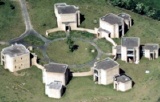Trends in Mathematical Crystallisation
3-6 May 2016
Organiser: Stefan Adams, Markus Heydenreich, Frank den Hollander, Sabine Jansen
Room D1.07
Participants: M. Baake (Bielefeld); L. Betermin (Heidelberg); X. Blanc * (Paris); D. Brydges (UBC Vancouver); D. Conache (Munich); L. De Luca (Munich); D. Dereudre (Lille); A. v. Enter * (Groningen); G. Friesecke (Munich); A. Giuliani * (Rome); T. Helmuth (Berkley); B. Jahnel (WIAS Berlin); G. Last (Karlsruhe); M. Lewin (Paris); J.P. Lions * (Paris); S. Kapfer (Nürnberg); W. Kendall (warwick); F. Merkl (Munich); S. Müller * (Bonn); M. Penrose (Bath); E. Pulvirenti (Leiden); E. Presutti (Rome/L'Aquila); C. Radin * (Austin); T. Richthammer (Hildesheim); B. Schmidt (Augsburg); F. Theil (Warwick); S. Taati (Leiden); D. Tsagkarogiannis (Sussex). [ * := to be confirmed]
The workshop concentrates on the mathematical theory of crystallisation. The workshop focusses on five topics that are closely connected with crystallisation, and approach these topics from different mathematical angles.
- Spatial symmetry breaking at positive temperature
- Crystallisation and surface effects at zero temperature
- Continuum particle systems (Gibbs point processes, metastability, and Percolation)
- Elasticity (variational analysis & gradient fields) and quasi-crystals/liquid crystals
- Differential geometry
The primary goal is to discuss the different approaches towards crystallisation in these disciplines (analysis, probability theory and statistical physics).
Vision: Crystallisation is the (natural or artificial) process of formation of solid crystals precipitating from a solution, melt or more rarely deposited directly from a gas. Crystallisation is also a chemical solid-liquid separation technique, in which mass transfer of a solute from the liquid solution to a pure solid crystalline phase occurs. In chemical engineering crystallisation occurs in a crystalliser. Crystallisation is therefore an aspect of precipitation, obtained through a variation of the solubility conditions of the solute in the solvent, as compared to precipitation due to chemical reaction.
Crystallisation poses major challenges for mathematicians - it is one of the challenging open interdisciplinary problems involving analysts, probabilists, applied mathematicians, physicists and material scientists. There are many open questions, among which are the following. Most of these have been discussed at the workshop 'Facets of mathematical crystallization' - Lorentz Center Leiden, September 2014. A key challenge of the workshop is to address and clarify their potential further.
Open Questions
(I) What characterises a crystal? What characterises different forms of spatial order?
(II) What should a system be called for which rotational symmetry is broken but translational symmetry is not? A liquid crystal or a hexatic crystal?
(III) Is translational symmetry typically broken at low temperature in $ d\ge 3$? What aspects of the interaction potential are crucial for this? Repulsion at short distances and attraction at large distances?
(IVa) What do zero-temperature models tell us about positive-temperature models?
(IVb) Can hard-sphere (or otherwise geometrically constrained) systems teach us anything about systems with finite interactions?
(IVc) What is the role of Pirogov-Sinai theory in this context?
(V) Are (small numbers of) defects essential to stabilise a crystal at small positive temperatures? Are crystals typically metastable (because they are obtained after a temperature quench)?
(VI) What can be learned from liquid crystals? What are the order parameter for positive temperature?
(VII) What can be learned from continuum percolation systems in $\mathbb{R}^2$?
(VIII) Does discretisation introduce spurious ground states? In other words, does coarse-graining introduce extra ground states that are not present without the coarse-graining?
(IX) What can the Cauchy-Born rule explain for crystal structures and elasticity?
(X) Is translational symmetry typically broken at low temperature in $ d\ge 3 $? What aspects of the interaction potential are crucial for this? Repulsion at short distances and attraction at large distances?
(XI) What needs to be measured about a crystal in order to identify its structure?
(XII) How does the theory of finite crystals (Wulff shapes, gradient mod- els, sharp versus rounded edges, etc.) relate to the theory of infinite crystals?
(XIII) What is the role of quantum mechanics for crystallisation?
(XIV) Does the theory of granular media have any bearing on the theory of crystallisation, and vice versa?
(V) Should physicists not have the ambition to build physical systems that can exhibit any thinkable form of crystallisation?
See also:
Mathematics Research Centre
Mathematical Interdisciplinary Research at Warwick (MIR@W)
Past Events
Past Symposia
Where possible, visitors should obtain an EDUROAM account from their own university to enable internet access whilst at Warwick.
You can register for any of the symposia or workshops online. To see which registrations are currently open and to submit a registration, please click hereLink opens in a new window.
Mathematics Research Centre
Zeeman Building
University of Warwick
Coventry CV4 7AL - UK
E-mail:
MRC@warwick.ac.uk

